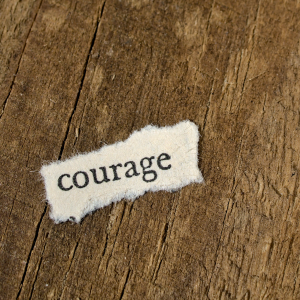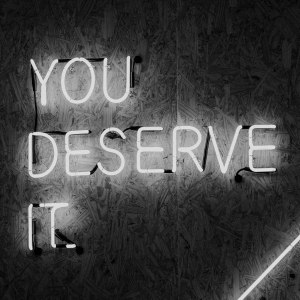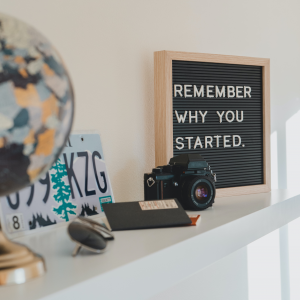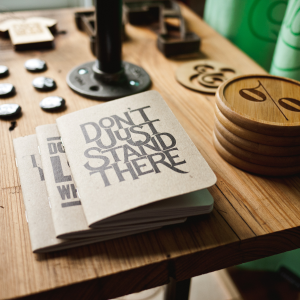In this episode, I’m talking about how you can make your thoughts work for you instead of against you. Listen to learn why thoughts are not facts and some strategies to help you think more helpful thoughts that will move you forward in life instead of keeping you stuck.
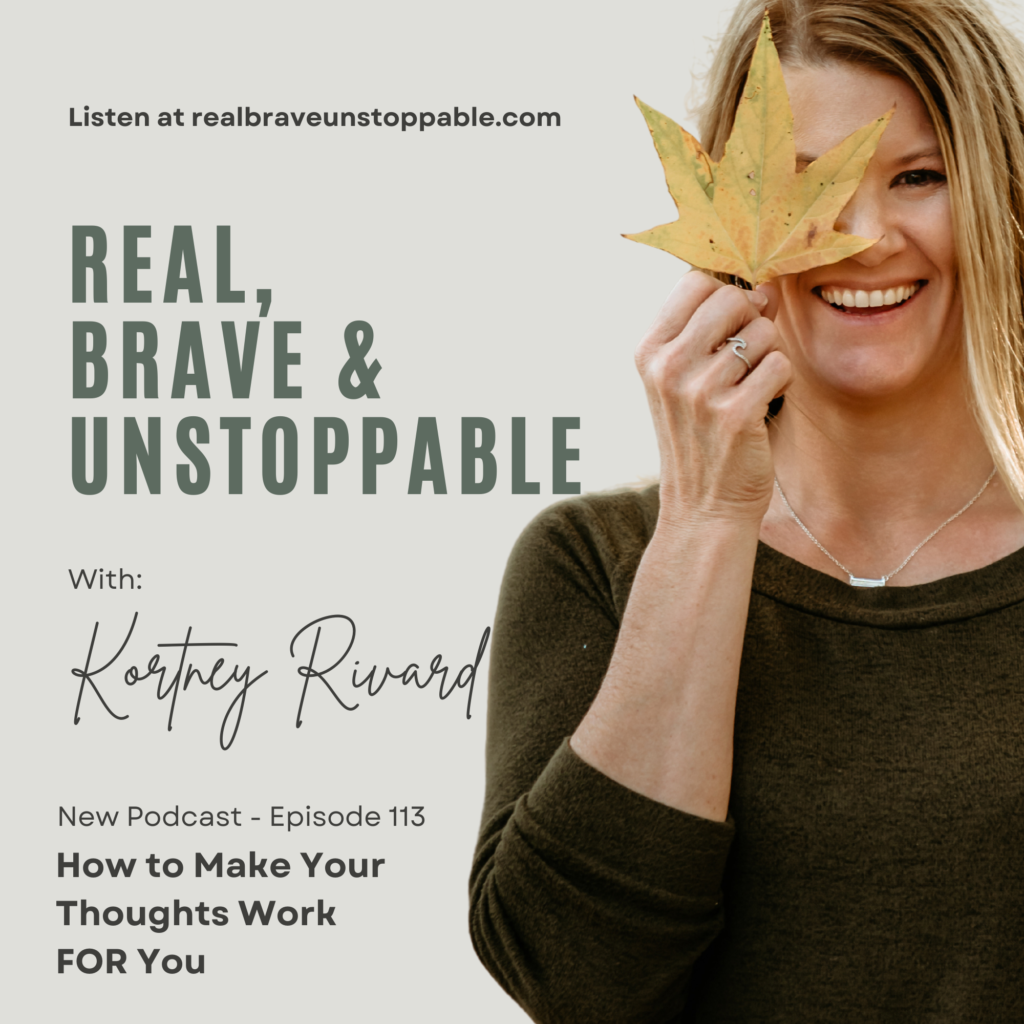



Show Notes:
Welcome to Episode #113 of Real, Brave, & Unstoppable!
In this episode, I’m talking about our thoughts. While thoughts can be really helpful, we also have a LOT of them that are entirely unhelpful.
The issue is that we believe the thoughts as facts, and that gets us into some places that feel pretty tough.
One of the game-changing concepts in my growth journey is that thoughts are not facts.
When I learned that just because I was thinking a thought (i.e. I’m not enough, I’m a failure, I suck at this, etc) didn’t mean that it was true, I was able to start developing a lot more flexibility in my brain. I was able to look at things differently and begin questioning the thoughts, stories, and limiting beliefs that were keeping me stuck.
In this episode, you’ll learn:
- what thoughts really are and why they can be so unhelpful sometimes
- strategies for distancing from your thoughts
- how to challenge a “sticky” thought and work on creating new ones
- the ins and outs of dismantling limiting belief systems and building up new ones that are more helpful to you in living the life you want to live
Have a listen and don’t forget to leave a rating and review!
Resources

How to Create the Life You Want FREE workbook
Click HERE

Podcast host and life coach, Kortney Rivard, has helped dozens of people get a handle on the perfectionism that holds them back so they can live happier, more fulfilling lives. Book a call to chat about how you can start changing YOUR life today.
CLICK HERE
Support the show (https://www.buymeacoffee.com/kortneyrivard)
Other episodes:
- Ep 122: How to Take the High Road When People Say Mean Things About You
- Ep 121: 5 Ways to Make the Mirror Your Friend
- Ep 120: Getting Back on the Goals Bandwagon – Setting Better Goals
- Ep 119: Slow Down! How to Embrace Getting Still and Waiting Patiently
- How to Fix Your All-or-Nothing Thinking
The Real, Brave, & Unstoppable full episode catalog
Transcript:
Episode 113:
Hello everyone and welcome back to real, brave, and unstoppable. I think I say this every time recently, but thanks for your patience in waiting for episodes these days. I’m trying to balance everything and the podcast is something that doing once a month feels doable right now. So, rest assured at some point we’ll be able to kick up that cadence a little bit and get some more episodes out to you. I love seeing when I have a new episode, I have so many downloads and it’s great to see that this podcast is getting out there and people are listening to it. And it’s helpful for a lot of people. So I’m really proud of that and just know that eventually I’ll have a lot more episodes for you, but just right now I’m trying to balance a lot of things.
So today I’m going to talk about our thoughts and how to make your thoughts work for you. I’ve talked about this before a little bit, but recently I’ve been coaching a couple of people for whom this topic has been, so game-changing. So today I want to talk about how our thoughts get in the way and what we can do about that. How you can make your thoughts work for you.
Okay, so let’s dive right into the topic of thoughts and how to make your thoughts work for you.
So the first thing is I’m just talking about understanding what a thought is. Thought is really just how we make sense of things. Your thoughts are really just words. And our thoughts come from stories and narratives and beliefs we have about the world and those things have come from when we’re little. We’ve taken those and carried them with us through our entire lives. We’ve picked up new ones along the way, and you know, pretty soon, they become truth for us. They’re the lens through which we see our lives. That’s our perspective. Why are we even talking about this? The problem is that we tend to create a self that can manage the uncertainty of the world, you know, it makes sense of the world. We’re able to create certainty through our thoughts and control through our thoughts. And the problem is that we then become too close to the thoughts and we think that they’re facts. When we have a thought that’s unhelpful, we don’t really always stop to question it. And, you know, things like I’m not good enough or so-and-so doesn’t like me, or I should be this kind of a mom or, you know, because I failed at that, that means I’m less of a person or, you know, thoughts like that, or even little tiny sneaky thoughts like I’m fat or – I don’t know that that’s a tiny thought – but, you know, sneaky thoughts like that, where we’re looking in the mirror and those thoughts are saying that we’re not pretty enough, or we’re not thin enough. You know, when we compare ourselves to other people, those thoughts are not helpful. And so that’s why we’re talking about this today. You know, we recreate the world in our mind so we can try to control it and create certainty. And then what happens is we live in our mind because we can control our mind, but we can’t control the world. So it creates this feeling of empowerment and like, you know, control. It creates certainty in our minds. But then we’re identifying with our brain, that’s when we’re living inside of our mind because we’ve created that certainty. And the problem with this is that when things don’t line up on the outside, then we think something’s wrong.
So there’s a book called the untethered soul that I love. It was my first foray into this concept of thoughts are not facts or that I am not my thoughts or how to make your thoughts work for you. The concept is that I’m just the observer of my thoughts. So I’m going to refer to the untethered soul a lot today. And that book is by Michael A. Singer. So if you want to check it out, highly recommend it. But the sort of the foundation of that book is really talking about how, you know, I just mentioned, we recreate the outside world inside of ourselves and then we live in that mind. We see the world through this lens and that lens helps us make sense of it. It creates certainty in our brains and our brains don’t like uncertainty. Have you ever gotten into a place where something isn’t certain and you kind of freak out about it? Yeah, me too. So that’s, that’s our brains do not like to have things uncertain. We go through life thinking we’re supposed to figure out how life should be and then make it that way. So how did we come up with the notion that life isn’t okay just the way it is? Or that it won’t be okay just the way it will be. And this leads me to talk about…I’ve mentioned this quote before, but Pema Chodron, who is a Buddhist nun, one of my favorite quotes is that, and I’m going to butcher this. This is just paraphrasing, but, she talks about how the reason we suffer is because we cling so tightly to the way that we want things to be, or the way that we think things should be. And the problem is we have no control over that really. We don’t have full control over that. Maybe some parts of it we do, but we suffer because when we can’t make that happen, we think that something’s wrong. And then when we think something’s wrong, that creates a whole set of new problems.
One of the things, as I was researching for this episode, one of the things I came across was a quote or writing, an idea that it’s actually possible to never have another problem for the rest of your life because events are not problems. They’re just events. It’s the resistance you have to the problems you know, the events. That is what causes the problem. So, if you didn’t have any resistance to the event, it wouldn’t ever be a problem. Right? So what I mean by that is, let’s say somebody says something to you that isn’t very nice. So maybe it’s not very nice, but the fact is like the perspective of it is neutral before we give it any meaning. Whatever that person says is neutral before we give it any meaning. And it doesn’t mean that it can’t hurt. If someone says something that’s mean. But it’s the resistance to it? Like what does that person think of me? Should I be different? That’s the resistance. So then it becomes a problem. That person said something means to me. What does that mean about me? So that’s resistance. So if we can let go of that resistance and just be like, huh. That person said something mean to me, that kind of hurts and I feel XYZ. But, I’m not going to make it a problem because I can’t control what they say about me. Now that’s easier said than done. It takes a lot of practice, but that idea can be really helpful to think about when you’re doing the work to make your thoughts work FOR you.
So we’re talking about thoughts today because we think they’re helping us navigate life. And at the same time, the thoughts in our brain do help us navigate life. But while our brain is such an amazing, amazing thing, sometimes it just, isn’t very helpful. And it’s almost like oh, my God. There’s like a glitch in the program here. What is going on? It’s gotten faulty data somewhere along the line. And really that’s kind of what it is. You know, the limiting beliefs that we have, it’s faulty data. We’re saying the sky is green, but we’re looking through green glasses. That’s kind of what that’s like. So, what do we do about this? This is part I love because game-changer number one is just simply self-awareness. One of my favorite quotes, and I don’t know if I made it up or someone else made it up….A client of mine recently said I should put this on a t-shirt. So I’m thinking about that with the podcast name – Awareness is half the battle. And it really is friends. It really is, because until you know what’s going on in your mind and in your emotions, and in your body. It’s really tough to do anything. Really tough to make your thoughts work FOR you. It’s really tough to see when you’re hooking into things that aren’t helpful and to, you know, take steps to unhook from that, for example.
When I introduce this concept to people, a lot of times we’ll have them start with a practice of what we call mindful awareness. And this is really so they can start to notice what they’re thinking and feeling and how those thoughts and emotions actually create our reality. And here’s where things get a little mindblowing. Your thoughts don’t define you. Okay? They’re just outputs of what your consciousness perceives. So you perceive something and your brain registers something, right? And then it spits out all these thoughts about it. It’s the computer program that’s running. But somebody else might have a completely different lens that they’re looking through, so they perceive that event or circumstance completely differently. You know, we have this inner monologue that never, never shuts off. Our brain spits out over 60,000 thoughts a day. So it’s just always going. And here’s an example. This is so funny when I have clients do stream-of-consciousness writing…Stream-of-consciousness writing is where you set a timer, you take out a pen and paper or even a computer and you just write or type, and you don’t stop. You do not take your pen off the paper. You don’t stop typing. A lot of people will be like, ‘Yeah, but what if I don’t have a thought?’ And then I say to them, well, that’s a thought too. So it’s a little mind-blowing. Like everything is a thought! Start to notice that. It’s just kind of funny.
One of the reasons people get so hung up on meditating…is because they think they’re not supposed to have thoughts, but the idea is that we always have thoughts. We’re always going to have thoughts. It’s the ability to notice the thoughts and let them just be there without hooking into them.
The untethered soul talks about two Selfs. The personal self and the actual self. The self capital S self is a pure stream of consciousness that’s always flowing. So always aware of the thoughts you’re thinking. Aware of what you’re observing. And then there’s the personal self. Which is the identity that you form. And it’s based on how your inner voice perceives the stream of consciousness and the thought patterns that come out of it. All right. So that consciousness is just taking in everything. And then the personal self is making sense of that and it kind of interprets it through whatever lens of beliefs and stories you have. So we all have a self-concept that is made up of the thoughts that we have about ourselves in the world. This is like who we think we are. And it’s never really who we are. It’s just like, our brain has created this. You can maybe also call it the ego. But we create this self-concept to fit into the world, to create certainty, to define ourselves. And that’s how we decide, like by having that certainty of who we are, that’s how we see ourselves in the world. It’s how we fit in. It’s how we figure out how to navigate it. And because the structure is how we see ourselves in the world, our brain is going to do anything to keep that intact. So we defend it. We defend those thoughts because who are we without those thoughts? This is my identity. This is how I create certainty in the world. This is how I make things all work. And sometimes it’s not super helpful, but when we defend it, we look for evidence to support it. And it’s just human nature. We’re always going to look for evidence of the thing we believe. Our brain does not naturally look for evidence that refutes the thing that we believe. And sometimes, the evidence is based on past experiences, et cetera, that color thinking and create what we call thought errors. Just think about it like a computer program error.
Let’s use the example…I’ve had several clients recently who we’ve talked about being peacekeepers when they were little. They really had to not show a lot of emotion, like kind of reading the adults all the time, making sure that they kept things like maybe they had younger siblings had to keep things really even-keeled so that things stayed calm. So that worked for them then, because they needed to have some sense of stability and calm in their household. So they learned that as long as I keep the peace, then things are good. But then when they got older, all of a sudden, now they’re trying to keep the peace with everybody. That’s their identity. That’s how they keep themselves safe. That’s how they keep others safe. And so that becomes a thought error. The thought can be many different things. I have one client whose self-worth is really hung up on keeping the peace and keeping everyone happy. That’s a thought error because that’s not how you keep people happy, right? And nothing against my client at all…it’s a faulty thought that it worked at one point and now it doesn’t but our brain can’t really see the difference unless you’re really intentional about it. But we present this package of beliefs as who we are. It’s not who we are that I can impress that upon you enough.
And here’s where things get a little ‘meta’. You are not your thoughts. I said this before, but you are not your thoughts. You are the awareness that is observing the thoughts. So you’re not that self-concept that you’ve created in your mind. You’re just the observer of it. Okay. So it’s almost like you’re going up about 20,000 ft and you’re watching yourself, like, it’s an out-of-body experience kind of if you think about it kind of like that. Or if you think about it, as you know when people say, I can’t see the forest through the trees…when you’re in your personal self, like in your mind, you’re in the forest and you can’t see the bigger picture, but like the awareness that you are is like rising above it and being able to see the whole forest. So when you can think of your mind as those two entities, I talked about the self and the personal self, you can envision those separate things. And you can envision yourself stepping above and observing all of this thinking that’s going on. This is where the game changer happens. The only real solution is to take the seat of the witness and completely change your frame of reference. So in one of the coaching programs I took, my mentor talked about something called an old tired path. And basically, so the old tired path is being in the forest going through, like, let’s just say you’re somebody who it feels like you have to prove yourself. And that creates one whole set of issues. But on the other side, if you don’t prove yourself, you think you’ve given up and that doesn’t feel good either. So you’re on this path of like same results either way, really?
The game-changer is where you can notice that and you can change your frame of reference. So now you’re just a totally different way of being like what would happen if that was possible to get off of that path? And to think about it like there are two distinct aspects to your inner being. There’s you the awareness or the witnesser of things. And that, which you watch. So there’s the stuff you watch, which is the thinking mind, the thinker. And then there is you, the awareness. You’re not the thinking mind, you are aware of the thinking mind. You’re the consciousness that’s behind the mind. And you’re aware of your thoughts. You’re aware of your thoughts. This is why self-awareness is so helpful because you start to see where these thoughts go awry. Where they’re not helpful. So thinking is something you watch the mind do.
The self simply notices that the mind and the emotions are unraveling. And kind of accepts that you might not like it, but is able to sort of just let it be there and observe it. Because that’s stuff changes. Nobody has ever become truly okay by changing the things on the outside, there’s always the next problem. The only real solution is to take the seat of the observer and completely change your frame of reference. As long as you are in there trying to manipulate the outside to match the inside. You will never be free or happy truly. You need to work on the inside and then you find the things on the outside that work for you, that are you. So you got to break that habit of thinking the solution to your problems is to fix the things on the outside. And going back to that idea of problems, the perception of problems, like what if these things weren’t problems, they just were circumstances. They’re just events.
So this all starts with entertaining this concept of observing and practicing awareness. And remember awareness is half the battle! So keep your eyes out. I may come up with a T-shirt… I think it’s a great idea. So shout out to my client Alyssa who came up with that idea! I hope you don’t mind me mentioning your name!
The second game changer is that you do not have to believe your thoughts. Which can also be called a narrative, story, or limiting beliefs. And this is where things get so fun. First of all, what are limiting beliefs? I already kind of covered it, but I didn’t really talk about it as limiting beliefs, but belief systems are just like a structure of, you know, thoughts. It’s like your lens. This is how I see the world. So, you know, I mentioned peacekeeping like that could be a belief system that I need to keep the peace. This is my job. This is how I find my worth – to make people happy, to keep the peace. And if things, if I don’t keep the peace, things are gonna fall apart and things will be terrible. Or perfectionism is another example of a limiting belief set. I need to be perfect to be good enough. I fear criticism. I don’t want people to think I’m not good at this. And not as one that I have a lot of experience with this one. And it’s a tough one to get over. But those are a couple of examples. So, how do we get some perspective? Remember we talked about, just changing your perspective, getting off of that path, and seeing things from a different frame of reference? Here’s what I like to do. Three N’s-notice, name, neutralize. The first thing for when you start to practice awareness of your thoughts,the first thing, and this also works for emotions too, by the way. But the first thing that you can do is just notice it. And then naming it. And the way to do this, there’s a subtle shift, nuance in how to like, think about it or how to, how to say it to yourself. Instead of saying the thought like it’s a fact. Like, I suck at this…You want to say, oh, I noticed I’m having the thought that I suck at this. So you’re the noticer watching this thought come out. So you’re just distancing yourself a little bit. There are some other ways that we can distance ourselves from our thoughts too, which we’ll cover in a minute.
And then the second thing, the second tool to sort of help us neutralize those thoughts a little more is to challenge them. Look at the evidence for and against. And we’ll talk more about that in a minute too, but this creates a more flexible perspective. You want to be able to look at the stuff from many different angles instead of just the one, you know, the one lens. The green glasses that create the green sky. You want to be able to try on all the different colored glasses. And remember your mind wants to create certainty. So it’s going to look for evidence to support the beliefs you have. So you have to, you have to be kind of strong in this and like really be intentional. You know, you’re the one who’s trying to use the analytical mind to protect yourself. So, what you’ll see is that your mind is always telling you that you have to change something outside in order to solve your inner problems, but if you’re smart and you’re aware, you will not play this game. You’ll be like, no thank you brain. Thank you, but no thank you. Um, that’s a distancing tactic by the way. And I’ll again, talk more about that in a minute.
So when we want to do that, though, when we want our brain to manipulate the world in order to fix problems, like our own problems, it’s an impossible task. Impossible. And then you’re not living your life. You’re living in your mind. This is where hamster wheel syndrome happens – when you’re living in your mind and not you’re actually not living your life.
Okay. So, as I mentioned, the first thing is to notice this awareness is such a game changer, just to be able to step back and notice. Self-awareness. And then ask yourself, is that thought working for me? So I have another client who was really frustrated with someone she was working with and her thought was that he shouldn’t be doing his job that way. He should be doing it this way. And that’s fine. There’s nothing wrong with that thought in and of itself. But the question really becomes is it working for you? And it was creating a lot of stress for her because she was so frustrated. She wanted him to be able to see that he should do his work a different way. And the problem? Well, I think you can guess, that she can’t control how he shows up. So you have to ask, is it working for you? And if it’s no, then we have to figure out how to look at that from a different frame or frame of reference. And remember that, you know, I noticed I’m having the thought that this guy should be doing his work differently. And my way is better. Also, remember, I mentioned this earlier, thoughts are just words. They’re just words. They are sentences. You get to decide which ones to keep. So if you want to keep a thought fine, but you gotta ask yourself, is it helping me? Are my thoughts working FOR me?
So then we move into what are some other ways that you can distance yourself from thoughts. To just step back and see the whole forest, like, oh, that’s just a thought. And some ways that you can do that, I already mentioned like, I notice I’m having the thought that, but other things you can do, or just imagining your thoughts as leaves on a stream. You just notice a thought and imagine it’s on a leaf on a stream and it just floats away. So let it go. If you notice that you’re having a hard time letting one go, you just keep putting it on the leaf and it goes down the stream. And in fact, there’s a great audio online, If you search for Russ Harris, leaves on a stream, there’s an audio that takes you through that. It’s great. I’ve had so many clients really love that one. Another way is to picture your thoughts as clouds that are just passing by, like you’re the sky, the thoughts are just coming and going. You can picture thoughts as suitcases on a conveyor belt, or you can picture them as words on a computer screen. Play around with the font in your mind, the colors. It takes some of the power out of the thoughts to just think of them as a sequence of letters and words to form sentences.
The next tool that we have is challenging our thoughts. And this is like when thoughts are really sticky. And if it’s a belief that’s very strong and it’s tough to just distance from it. It just kind of keeps coming back. There’s a woman named Byron Katie…she has a book called four questions that will change your life. And she calls her method the work. And the four questions are, is that thought true? The second question is no…is it really true that, can you prove it? Three: is there a reason that is stress-free to keep the thought? And then four is who would you get to be if you didn’t have the thought anymore? If it wasn’t a problem for you? It can also be helpful to like, when you’re asking yourself, if it’s true, that first question can be sneaky for some people because sometimes people will be well yeah, I do think it is true. But the real question is, really can we prove this in a court of law? So that’s where you can go to evidence. What evidence do I have that this is true? And what evidence do I have that it’s not true? And more often than not, you will find more evidence, if you look for it, that’s for it is not true. Your brain will come up with the evidence for why it’s true a lot faster, but you have to kind of stick with that one. So those are some things that we do when we notice thoughts when we’re in awareness and we’re noticing thoughts that are not helping us. And that’s when we go, okay that one’s not helping. I don’t want to keep it. I need to figure out how to find a new frame of reference, a new perspective on this.
So distancing, challenging. So, you know, the tough part in all of this is that sure…I can talk about this all day, but you actually have to do it. And that can be hard. A quick, quick little refresher on thoughts, feelings, or emotions and actions or outcomes/ results. We have a thought about a circumstance. And it’s all like what, like we’ve talked about today, our thought is based on our experiences and that’s our lens, right? So whatever thought we have, it creates a feeling. If you think about somebody walking into the room that you can’t stand and your thought is, oh my God, I hate that person. You might feel disgusted or angry or I don’t know, whatever, but, if you have the thought, oh, I’m so happy to see her…Your feelings are going to be very different. Maybe happy, excited. So the thought we have creates the feeling. And then the feeling, if we’re hooked into the feeling, will dictate how we show up. It determines our actions, then it’s running the show. So that’s how they’re connected. And obviously, the action or the behavior affects the result that we get. So you’re going to have to take action towards what you really want, even if you’re uncertain, or if you have negative thoughts or limiting thoughts or fears. And that’s hard sometimes.
Go back to the courage I talked about at the beginning of today. Because that feeling you’re going to feel, if you let’s just say you feel, depressed or frustrated or, you know, in your action is typically to either like lash out or even just to kind of shut down, those actions are not getting you the outcome you want, like that’s where we got to work. That’s the hard part though. When you feel, let’s just say you feel depressed. And you don’t have a lot of energy to get up and do something. And let me just, I want to just stop and clarify something. People that struggle with depression… I am not in any way saying that you should just be able to get up off the couch and do the opposite thing. Not saying that at all. I’m talking more about it, I should probably change the word to let’s just say you’re feeling sad. So if you’re feeling sad and you’re having a hard time, like getting moving, for example, it might feel really uncomfortable to get moving and carry on with your life. Like carrying that sadness, because a lot of times what we do is wait for a better feeling to be able to take action.But that’s not really how it works because that’s like you’re staying in your comfort zone.So in order to really make changes, You need to be able to recognize when you’re feeling not so great.And you have to be able to do the thing anyway, what’s important to you here?And how do you want to show up? And even though I don’t feel good, How can I take a step towards what it is that I really want in life or who I want to be in life? So a few things to keep in mind with that.One is just, like I said before, remember. Doing comes before confidence. It’s not going to feel good when you start to shift some of these thoughts. Cause they’ve been protective. And they’ve worked for you at some point in your life like acknowledging that they worked. They don’t work anymore. But if you wait for it to feel good, You’re never going to take this step. And then you’re not even in control of it. You have control over when you take the step. So just do it. Even if it feels bad. The second thing is really to look at your relationship with failure. Like what’s the problem? If, what a failure, wasn’t a problem. You can insert your own version of this here. Like, you know, what if people pleasing wasn’t a problem? What would life be like then? But going back to failure, because I think that can be such a big one, but failure can be a really good teacher. Somebody said to me. Yeah. But I never feel that in the moment. And I laughed and I was like, you’re not going to, like in the moment when you fail, you’re not going to be like, oh good. I failed. I failed. I get to learn something. No, you’re going to feel like shit. But it’s in the work after like, you know, you failed, you feel like shit, but you’re still going to take a step towards what it is that you. You know, what’s important to you. That’s the magic. That’s the secret sauce. The next thing is to like stepping through some of these thoughts that might hold you back.It’s like, you know, sometimes with perfectionistic type ones, remember the word yet?Like, so sometimes people will be like, I don’t know how. That thought, that’s not a super helpful thought. I’m not good at that. I’m not, I don’t know how I’m not good at that. And sometimes just putting that word yet afterwards makes a big difference. And then work on believing that. I’m not good at that yet. I can, I can work on that. A couple of examples, just to wrap this up.I’m going to share one related to body image because I think this one, I see this come up so much and it’s come up in myself as well. When people really want to be a certain body shape or size, weight, whatever it is, so the thought is things would be better if I’m just gonna make this up, but things would be better if I wore a size that was two sizes smaller or things would be better if I only would lose 20pounds.So that’s the thought. That’s not super helpful because we are then trying to create on the outside, the body, which is outside. We’re trying to create that to make us happy on the inside. And so if that comes up, it’s like, oh, I noticed that I’m there. There’s that thought I noticed that I’m thinking I, I would tell them I’ll solve my problems. If I’m 20 pounds lighter. You know, I noticed that, and then I didn’t mention this before, but one of my favorite things too is to thank your brain for that information. Thanks. But no, thanks. Not helpful. And just like, kind of remind it that, Hey, you know what, I get, I get that. That’s what you think, but not a super helpful thought. But thank you. That can kind of help place some distance between it as well. But in terms of taking action, you know, like trying to believe the thought that that’s not, what’s going to solve the problem. It’s scary for people because what comes up is, well, if I don’t have that thought, I’m not going to push myself. And if I just accept where I’m at, then I’m gonna like, you know, gain all this weight and just let everything go and things will be really bad. That’s kinda what keeps people stuck.But instead, if you say, you know what, that’s really not helpful. Like who do I want to be in this situation? I want to feel empowered to take care of my health. So what is the decision that I could make to do that? And that might feel uncomfortable to let go of that thought because of what I said, like you’re afraid, well, if I just accept this and take, you know, try to be who I want to be. What’s that gonna do to my body? Right? So that’s an example of where courage over, you know, courage before confidence with that. You just have to keep doing it, even if it feels uncomfortable. Another client of mine has a thing with asking for help because asking for help to her feels like failure. And there are a whole bunch of different thoughts that are part of that belief system. But the uncomfortable part for her is obviously asking for help because she feels like it says something about her as a person. And for her to ask for help like she’s never gonna overcome that series of thoughts if she doesn’t start asking for help.And so she’s like at one point she was like, well, I don’t really know how to ask for help. It’s just really hard. And so that’s where that yets word comes in. You don’t know how to ask for help yet. But we just gotta work on doing it. It’s courage before confidence. And one final example, another client of mine was like her to-do list at work. That’s how she defined her success at work – if she got everything done on her to-do list. Well, you can imagine how that went. How successful she actually felt at work because there’s always more that gets added to it, right? Again, then you’re trying to use something on the outside – the to-do list – to make you feel better on the inside. So I’m letting go of that thought. My to-do lists can wait. Letting go of the thought that I’m not successful unless I get all my to-dos done. Not helpful. But for her to let go of needing to get all the to-do’s.That brings up you know, beating herself up for not being productive. But to let go of that thought, it’s protecting her from being a failure, right? She’s a perfectionist. So it’s a protection thing against being a failure or people criticizing her work. And so to let go of that, it’s scary, right? Because then, what if I let go of this thought that I had to get everything done, and then now I’m not getting anything done? And then I get fired. This is where thoughts take us. So, for her it’s like, okay, practice not getting everything done on your to-do list. And then look at what thoughts come up. And then we work on the thoughts. You would distance. We challenge, or we look at what are some other thoughts? I gotta get that new, the new frame of reference, the new perspective.
So that is what I have on thoughts today. So to recap everything, what you want to remember here, if you take nothing else away from this episode – You are not your thoughts. Your thoughts are not facts. They’re just words. Okay? That was a few things, but they are sentences. So just remember that you have the option to keep a thought or not keep a thought. And when you can start a practice self-awareness to really, you know, just to notice what they are, you can start to, you know, get a little more like critical of like, oh yeah. That one’s not really very helpful. Why do I have it? Why do I hang on to it? How can I distance myself from it? How is it true? How can I challenge that thought? And if you need help with it, because the stuff is some of the most fun work that I do with people because it is kind of mind-blowing when people start to realize…like, they’ll start to actually try to explain how thought is true. When I suggest that’s just a thought too, it’s just like totally mind-blowing.
So if you want help with this, I am here for you. Let’s talk, shoot me an email at kortney at kortneyrivard dot com. You can go to the podcast website and fill out the contact form, or you can go to my website, kortneyrivard dot com, and fill out the contact form there as well. So with that friends, I hope this was really helpful. If you have any questions about it, feel free to message me as well. I always love to hear from my listeners. And before I go…if you could please take some time to rate and review the show. That would be awesome. It just helps more people find it. And, I’ve had a lot of great feedback and I just want to reach more people. So, if you wouldn’t mind doing that, that would be great. And again, hope it was super helpful and I will see you next time.


